Heal Pain (Figure 1)
Patients often complain of heel pain and there are several common causes of that pain. A correct diagnosis of the cause is essential to render the most appropriate treatment.
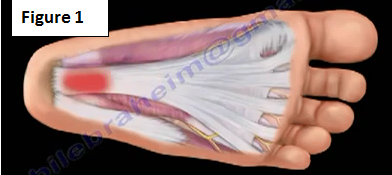
Common Causes Of Heel Pain:
1. Baxter nerve compression (Figure 2)
2. Plantar fasciitis (Figure 2)
3. Fat pad atrophy (Figure 2)
4. Achilles tendonitis (Figure 3)
5. Stress fractures of the calcaneus (Figure 4)
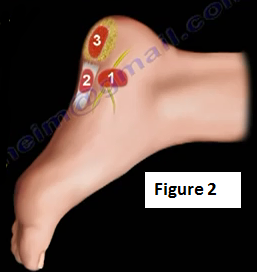


Baxter Nerve Compression (Figure 5)
Baxter nerve compression occurs when the first branch of the lateral plantar nerve becomes entrapped in the medial heel. The entrapment results in heel pain, paresthesia, medial heel tenderness, and abnormal sensation on the plantar aspect (bottom) of the heel. Typically, baxter nerve compression is seen in sprinters, dancers and gymnasts, who are frequently on their toes. This is because these athletes commonly have well developed abductor hallucis muscles, which often compress the lateral plantar nerve.
Treatment
Treatment includes heel stretching exercises, NSAIDS, orthoses, and surgery. Surgery will decompress the nerve at the fascia between the abductor hallucis and quadratus.
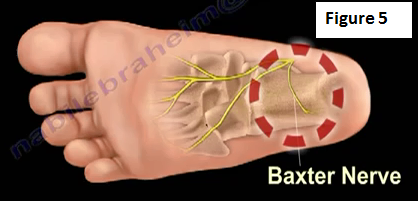
Plantar Fasciitis (Figure 6)
Plantar fasciitis is characterized by irritation and swelling of the thick tissue on the bottom of the foot. This fascia can become inflamed and painful making walking more difficult. Plantar fasciitis is most severe in the morning when patients first stand on their feet. Pain symptoms will intensify with prolonged exercise or standing.
Treatment
Treatment for plantar fasciitis includes anti-inflammatory medications, heel stretching exercises, and shoe inserts (heel padding). Simply walking often helps relieve the pain associated with plantar fasciitis.
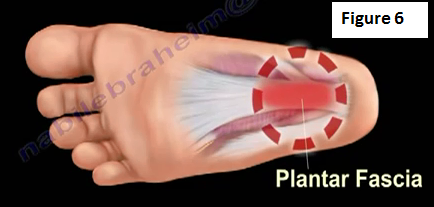
Fat Pad Atrophy (Figure 7)
In fat pad atrophy the fat that cushions the calcaneus is thinned. This condition is common in elderly people and can cause significant pain while walking. Fat pad atrophy is also seen in patients with a history of steroid injections.
Treatment
Treatment for fat pad atrophy includes anti-inflammatory medications, and shoe inserts (custom orthotics).
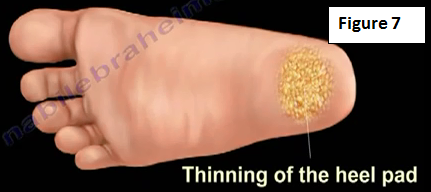
Achilles Tendonitis (Figure 8)
Achilles tendonitis is a chronic injury to the tendon that joins the heel to the muscles of the lower leg primarily occurring from overuse. Achilles tendonitis can make walking not just painful but also difficult. The achilles tendon gives us the ability to rise up on our toes, allowing for the act of walking.
Treatment
Treatment for achilles tendonitis includes anti-inflammatory medications, physical therapy, massage therapy, ice therapy and immobilization.
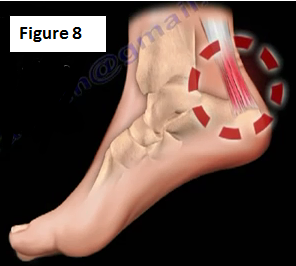
Stress Fractures (Figure 9)
Stress fractures of the calcaneus can occur as a result of overuse injuries. When a patient has a stress fracture they experience weight bearing pain and pain with side to side compression of the calcaneus. Stress fracture injuries of the heel are typically seen in patients who participate in running sports due to repetitive shock placed on the heel.
Treatment
Treatment of stress fractures includes rest, immobilization (partial to complete), and activity modification.

For more videos associated with these injuries follow the links below:
https://www.youtube.com/watch?v=lAu4XmB_HCc
https://www.youtube.com/watch?v=MApd4H1Isfk
https://www.youtube.com/watch?v=2UmY-VgBJjU
https://www.youtube.com/watch?v=eZF0XxUkJIM
For more videos, check out my YouTube channel:
https://www.youtube.com/user/nabilebraheim
-- This feed and its contents are the property of The Huffington Post, and use is subject to our terms. It may be used for personal consumption, but may not be distributed on a website.
No comments:
Post a Comment